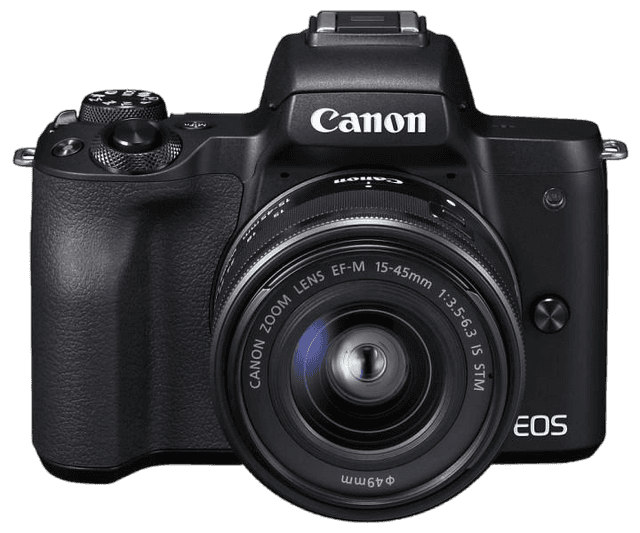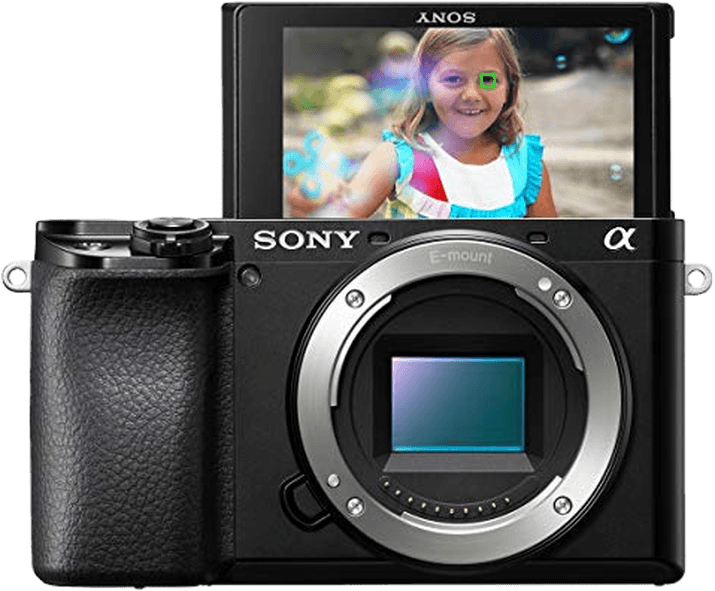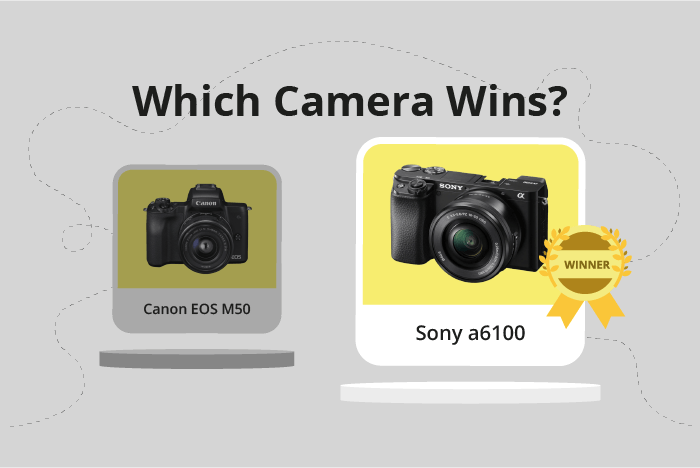Canon EOS M50 vs Sony a6100 Comparison
Canon EOS M50

Sony a6100

The Sony a6100 emerges as the winner with a score of 66/100, while the Canon EOS M50 trails behind with a score of 59/100. Both cameras are mirrorless and were launched within a year of each other, with the M50 in 2018 and the a6100 in 2019. They share similar dimensions and weight, with the M50 measuring 116 x 88 x 59mm and weighing 390g, and the a6100 at 120 x 67 x 59mm and 396g.
The Sony a6100 gained a higher score due to its better overall performance and features. Moreover, it was launched at a slightly lower price of $750 compared to the M50’s $779. On the other hand, the Canon EOS M50 has a slight advantage in terms of size and weight, making it a more compact option.
Taking these factors into consideration, the Sony a6100 is the better camera, offering superior performance at a lower price. However, if portability is a priority, the Canon EOS M50 may still be a suitable choice.
Canon EOS M50 vs Sony a6100 Overview and Optics
The Sony a6100 outperforms the Canon EOS M50 in optics with a score of 68/100, whereas the Canon EOS M50 scores 59/100. Both cameras share common specifications such as 24 megapixels, CMOS sensor type, APS-C sensor size, and the absence of image stabilization. Despite these similarities, there are key differences that contribute to the Sony a6100’s higher score.
The Sony a6100 has a faster shooting speed of 11 compared to the Canon EOS M50’s 10, allowing for better capture of fast-moving subjects. Additionally, the Sony a6100 has a significantly higher DXOMARK score for its sensor at 82, compared to the Canon EOS M50’s 58. This indicates the Sony a6100 has better image quality and low light performance. The Sony a6100 also uses the Bionz X processor, while the Canon EOS M50 utilizes the Digic 8 processor. The lens mount for the Sony a6100 is the Sony E mount, offering a wider range of lens options compared to the Canon EOS M50’s Canon EF-M lens mount.
The Canon EOS M50, however, does not have any specific advantages in optics over the Sony a6100. Both cameras lack image stabilization, which would have been a beneficial feature for either camera.
From the comparison, it is clear that the Sony a6100 offers better optics performance than the Canon EOS M50. With a higher DXOMARK score for its sensor, faster shooting speed, and a wider range of lens options, the Sony a6100 is the better choice for photographers who prioritize image quality and versatility in their camera equipment.
Canon EOS M50 vs Sony a6100 Video Performance
The Canon EOS M50 and the Sony a6100 both have a video score of 91/100, indicating their equal capabilities in video performance. Both cameras offer 4K video resolution with maximum dimensions of 3840 x 2160 and a maximum video frame rate of 120fps. Additionally, both cameras have built-in time-lapse functionality.
The Canon EOS M50 excels in providing a user-friendly interface, making it easier for beginners to navigate through settings and explore video options. This advantage caters to those who are new to videography or prefer a simpler camera operation.
On the other hand, the Sony a6100 stands out with its superior autofocus system, ensuring sharp and accurate focus during video recording. This feature is particularly beneficial for capturing fast-moving subjects or shooting in challenging lighting conditions.
Despite the shared video score, each camera has its unique strengths. The Canon EOS M50 is ideal for individuals seeking an easy-to-use camera with reliable video capabilities. Meanwhile, the Sony a6100 is well-suited for those who prioritize precise autofocus and the ability to capture dynamic subjects in their videos.
In comparing the video capabilities of these two cameras, it becomes evident that both are highly capable and offer similar video performance. The choice between the Canon EOS M50 and the Sony a6100 ultimately depends on individual preferences and specific video requirements.
Canon EOS M50 vs Sony a6100 Features and Benefits
The Canon EOS M50 narrowly wins in the features category with a score of 70/100, compared to the Sony a6100’s 68/100. Both cameras share several specifications, including a 3-inch screen, touchscreen functionality, flip screen, GPS absence, WiFi, and Bluetooth connectivity.
The Canon EOS M50 has a higher screen resolution of 1,040,000 dots, compared to the Sony a6100’s 921,600 dots. This higher resolution provides a clearer and sharper display, enhancing the user’s experience when composing images or reviewing captured photos and videos.
Despite the Canon EOS M50’s advantage in screen resolution, the Sony a6100 has its merits. The a6100’s autofocus system is more advanced, offering faster and more accurate focusing. This feature is particularly useful for capturing fast-moving subjects or shooting in low-light conditions.
In comparing the features of the Canon EOS M50 and Sony a6100, both cameras have their strengths and weaknesses. The Canon EOS M50’s higher screen resolution provides a better display, while the Sony a6100’s autofocus system is superior. Ultimately, the choice between these two cameras depends on the priorities and preferences of the user.
Canon EOS M50 vs Sony a6100 Storage and Battery
The Sony a6100 outperforms the Canon EOS M50 in storage and battery, with a score of 37/100 compared to the M50’s 13/100. Both cameras have one memory card slot and accept SD, SDHC, and SDXC cards. However, the a6100 also supports Memory Stick Pro Duo cards, providing more storage options.
The a6100 has a superior battery life, offering 420 shots per charge, while the M50 only provides 235 shots. The Sony a6100 uses the NP-FW50 battery, and the Canon M50 uses the LP-E12 battery. An added advantage of the a6100 is its USB charging capability, which the M50 lacks.
Despite the lower score, the Canon M50 still serves as a reliable camera for casual users who do not require extended battery life or additional storage options. However, for those seeking longer shooting sessions and more storage flexibility, the Sony a6100 proves to be the better choice.
Alternatives to the Canon EOS M50 and Sony a6100
Are you still undecided about which camera is right for you? Have a look at these popular comparisons that feature the Canon EOS M50 or the Sony a6100:

